Scottish Marine and Freshwater Science Volume 3 Number 3: Clyde Ecosystem Review
A review of previously published information and knowledge concerning the Firth of Clyde ecosystem and suggestions for further studies in the Clyde required in order to support sustainable use of this active Scottish marine ecosystem
3. THE ENVIRONMENT OF THE CLYDE SEA
3.1 Definition of the Clyde Sea
The Clyde Sea is defined as the marine tidal extent which encompasses the Firth of Clyde, the Clyde Estuary and the sea lochs to the north of the Firth and Loch Ryan in the south of the area. The islands of Bute, Arran, Ailsa Craig and the Cumbraes lie within the main body of the Firth. The outer boundary where the Firth of Clyde meets the Irish Sea extends from the southern tip of the Mull of Kintyre to Corsewall Point (Halliday, 1969). In total the Clyde Sea encompasses an area of 3600 km 2 and has a volume of approximately 180 km 3. ( Figure 3.1)
Figure 3.1 The Clyde Sea - defined by the boundary from the Mull of Kintyre to Corsewall Point.
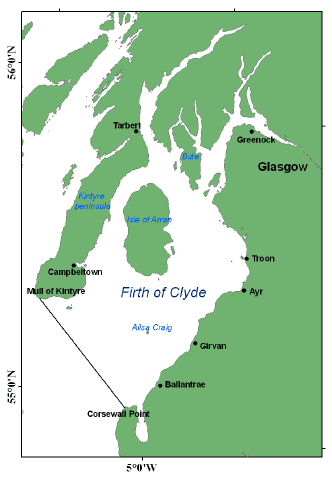
3.2 Geological History of the Clyde
The formation of the Clyde Sea as we know it today, along with the rest of the Highlands, began 500 million years ago (all the description that follows comes from Jardine, 1986). It lay between a major land mass to the northwest, and an ocean (the Iapetus Ocean) to the southeast. It then lay far south of the equator. Over the next 150 million years it drifted northwards to the equator with the movement of the continental plates, undergoing changes in the geology and structures associated with the Highland Boundary Fault. About this time volcanic lavas produced the structure that would become the Great Plateau at the mouth of the Clyde. Further changes occurred caused by the immense geological processes underway, but the underlying rock structure of the Clyde basin as it is today was complete about 70 million years ago, by which time the Clyde lay roughly at it's current latitude.
During the Tertiary period, from about 70 million years ago to 2 million years ago, the Clyde underwent numerous erosional and depositional events, including local volcanism. Then during the Quaternary period, from 2 million years ago to about 10,000 years ago, Scotland was covered by ice sheets more than 17 times. During each coverage of ice, and in the warmer periods between the ice sheets, areas were eroded, sediments laid down, and the land moved vertically up and down owing to the removal and imposition of the weight of the ice. At the same time sea level changed repeatedly. Thus there is a complex patchwork of eroded gullies and basins, deposited marine and riverine sediments and rock structures throughout the current Clyde basin, both below and above present sea level.
Finally, the last glacial period occurred, reaching it's coldest about 18,000 years ago and ending about 10,000 years ago. An aerial view of the Clyde during this time would have shown huge ice sheets flowing as glaciers across the area from the highlands westwards out to the continental shelf edge. The deep rock basins of Kilbrannan Sound and southeast Arran were carved out down to 160m, much deeper ( i.e. "over-deepened") than the hard volcanic rock "sill" of the Great Plateau. Between Arran and Bute a basin 320m deep was carved. It is estimated that the amount of hard rock the ice sheet carved away was probably much greater than the total volume of the Clyde Sea today.
As the ice sheet began to retreat, it deposited "till", mainly sand, in the deep basins it had carved out, reducing their depth by up to 80m. As the ice melted, the sea began to flood the Clyde, probably starting 14,000 years ago and the Clyde Sea as we would begin to recognise it today forming over the next 500 years, although ice persisted latest in Loch Long and Gareloch. The Clyde Sea then became bigger than today, as land was lower compared to sea level owing to the effect of the weight of the ice sheet.
Once the sea flooded into the Clyde, so the deposition of the muds and clays began which again reduced the depths of the ice-carved basins behind the Great Plateau. These were partly eroded sediments, and partly the skeletons of dead marine plankton. The location of the shoreline now varied greatly as the level of both the sea and the land altered following the removal of the ice sheets, resulting in shoreline features seen today above current sea level.
Today, the land around the Clyde continues to rise slowly, and deposition of silts and clays in the deep basins continues.
3.3 Bathymetry and Sedimentology
As a result of the erosional and depositional processes described above, the Firth of Clyde is a region of complex bathymetry and sea bed sediment (Tivy, 1986). The glacial action has created a large fjordic system separated from the Irish Sea by a broad underwater sill and from the Atlantic by the Mull of Kintyre ( SSMEI). The broad sill, termed the Great Plateau, has an average depth of 40-50m, which divides the North Channel from the Arran Basin where water depths can reach 150m. The Arran basin itself exhibits complex bathymetry consisting of both deep channels to the north and relatively shallow shelving areas to the east ( Figure 3.2).
Figure 3.2 Bathymetry of the Clyde Sea. Lightest blue - depths of 22m, darkest blue - depths of 114m.
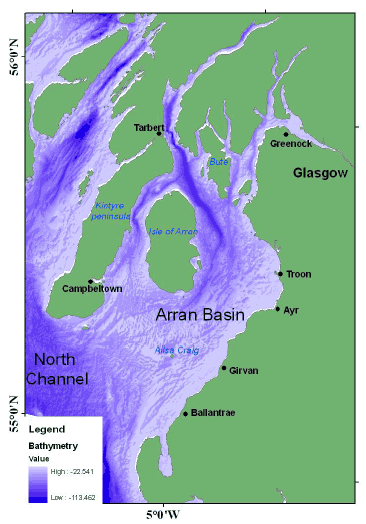
The sub-tidal environment of the Clyde Sea is predominantly sedimentary in nature. Moore (1931) described it as consisting of predominantly fine grained layered muds. The large expanses of muds in the deeper water extend around Arran into the deep basins of the upper lochs. Although the substrate is muddy throughout much of the area, the area does contain a wide range of habitats; there are long sandy stretches along the Ayrshire coast and there is hard ground along the edge of the deep channels in the North Channel and Loch Fyne. There are also narrow sea lochs with rocky shores and sandy bays ( Figure 3.3).
Figure 3.3 Sea bed sediments of the Clyde using the Folk triangle classification based on the gravel percentage and the sand to mud ratio. See Section 9.3.4 for a full explanation of sediment type codes.
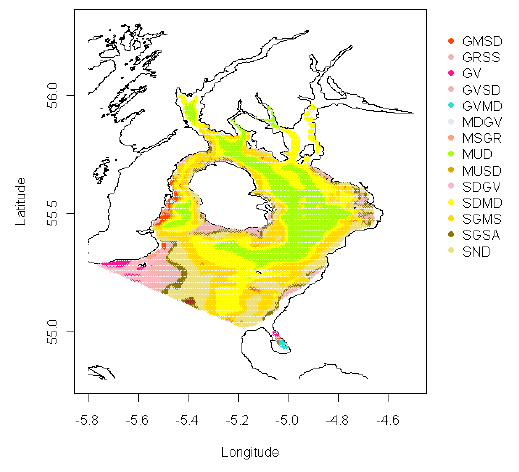
The hydrography of the area is also complex and is largely driven by its bathymetry. Salinity and temperature distributions described by Craig (1959) and Dooley (1979) point to a front on the Great Plateau which separates the tidally mixed waters of the North Channel from the stratified waters and weak tidal currents of the Firth. The maximum velocity of the tidal currents in the Clyde is generally less than 0.5 ms -1 and within the sea lochs they are even weaker attaining about 0.2 ms -1. The bathymetry controls the balance of processes at any particular depth. At the surface there is free connection throughout and movement is dominated by pressure gradients set up by tide, wind and freshwater outflows. In the deeper waters below the sills, dense water settles, flows are blocked and are dominated by oscillatory internal movements; bottom water stagnation, some oxygen depletion and nutrient build-up can occur within the lower levels of the sea lochs. However the importance of the deep water is sometimes overemphasised, by area only 20% lies below 70 m and 6% below 100 m (See section 9).
The basin also receives large inputs (60-700 m 3s -1) of freshwater from the River Clyde and other river sources which enter mainly through the north of the region (Poodle, 1986). The freshwater inflow produces a typical fjordic regime with the salinity of the outflow surface water reduced by up to 1.5 relative to the inflow over the sill. The effect of this surface water tends to maintain a stable stratification which is not seriously eroded by tidal stirring on account of the generally weak tidal flows (Simpson and Rippeth, 1993).
The temperature of the Clyde Sea, compared to the North Channel, is warmer in the summer and colder in the winter. The shallow waters of the lochs and estuaries experience much greater temperature fluctuations, surface ice forms at the heads of some lochs in the winter and a thermocline is established during the summer (Connor, 1991). Mean surface temperature and salinity vary quite considerably (depending on the season) from 6-14°C and from <30-34.75 respectively.
3.4.1 An Annual Cycle in the Clyde
Slesser and Turrell (2005) provide annual cycles of physical, chemical and some biological parameters in the waters around Scotland. These have been derived from the extensive water sampling performed by Marine Scotland Science since 1960. In this section we present average annual cycles of these parameters in the Clyde Sea, averaged throughout the Sea over a surface (0-10m) layer, and bottom layer (40m - sea bed). Note that as the values presented in this section are averages over both space and time, actuall values at individual locations, at specific times, can be very different, particularly for the biological parameter chlorophyll-a.
For comparison, data from an area defined by Slesser and Turrell (2005) as the Inner Malin Shelf have been used. Results from this area reflect typical conditions in the coastal waters west of Scotland, outside the Clyde. Slesser and Turrell (2005) provide all details concerning sampling, data processing, accuracies etc. Data from approximately 1600 hydrographic stations are included in the Clyde averages while only 350 are available for the Inner Malin Shelf.
Slesser and Turrell (2005) present figures for monthly averages of temperature, salinity, density, oxidised nitrogen ( NO 3), orthophosphate ( PO 4), silicate (Si), ammonia ( NH 3), particulate organic carbon, particulate organic nitrogen, chlorophyll-a, phaeophytin, oxygen and water column stability. Here we will focus on the physical parameters temperature (ºC), salinity and density (in terms of σ T , units kg m -3) to describe a typical year in terms of changes to the physical environment of the Clyde Sea ( Figure 3.5a). Chemical and biological parameters presented are oxidised nitrogen (referred to as nitrate for this text, units - μg-at/l), chlorophyll-a (μg/l) and oxygen content (percent saturation) to demonstrate the annual biological production cycle and its effects ( Figure 3.5b).
Annual changes in the physical characteristics of the Clyde Sea
In the Clyde, coldest winter temperatures are experienced in March / April when temperatures in the surface and lower water column are the same (~6ºC). Temperatures then start to warm, reaching a maximum in the surface waters in August (~13ºC). At this time bottom layer temperatures are still warming towards their maximum, implying a degree of isolation from the surface waters. This is confirmed by the salinity and density differences between surface and bottom waters which is maintained throughout the year. As temperature cools towards winter, bottom layer and surface layer temperatures equalise after October. Density differences between the two layers are minimum in February and November when mixing between the layers may be most frequent.
When comparing the average annual cycle of physical characteristics within the Clyde to those of the Inner Malin Shelf, the following comparison can be made: Clyde summer surface layer temperatures are similar to those in Scottish west coast coastal waters; maximum surface summer temperatures occur a month earlier in the Clyde; winter minimum temperatures are about 1ºC cooler; salinities are fresher owing to the local freshwater inputs; density stratification persists all year in the Clyde, although weakest in the winter, whereas coastal waters are predominantly well mixed.
Annual changes in the chemical and biological characteristics of the Clyde Sea
Nutrient content of the Clyde, using nitrate as an indicator, is generally higher in the Clyde than adjacent coastal waters, presumably owing to local nutrient supply from freshwater inputs. Winter values reach a maximum of 10-12 μg-at/l, whereas coastal maximum values are typically 6-8 μg-at/l. In the surface layer within the Clyde nutrient is depleted by June / July as a result of biological production, although bottom layer nutrient does not fall below 4 μg-at/l.
There are no available measurements of primary production found by this study from the Clyde. However, there are values of the instantaneous concentration of chlorophyll-a which can act as an indicator of the timing and magnitude of primary production. Two peaks are evident in the average annual values obtained from the surface layer within the Clyde, one in March and one in July. Both appear equal in magnitude. This contrasts to coastal waters, where a first peak in production may occur in June and a second, smaller peak in September. Maximum Clyde chlorophyll-a values are between 4-5 μg/l, whereas in coastal waters they are lower, typically 2-3 μg/l. These observations may suggest that, the Clyde is in general more productive than outside coastal waters, the biological cycle starts earlier in the Clyde and there are two distinct periods of productivity, one in the early spring and one in the summer. (Note that the values presented here are monthly averages over the entire Clyde Sea area. Maximum values at specific locations and times have been observed much higher than the maximum values stated here.)
A final parameter available from the annual cycles study of Slesser and Turrell (2005) is the oxygen content of the waters of the Clyde. Here, the percentage saturation is presented, although in biological terms the absolute oxygen concentrations may be more relevant. It is clear from Figure 3.5b that the surface layers of the Clyde are generally fully saturated, with values close to 100%. However, the oxygen saturation in the deeper waters decline in the summer months as stratification of the water column leads to partial isolation of the denser bottom waters. Natural utilisation of oxygen through the decay of organic material uses up oxygen until the waters are flushed by oxygen rich water in the autumn, when increasing winds and decreasing stratification mixes up the deeper waters and replaces them with oxygen rich surface waters. The seasonal depletion of oxygen is not seen in adjacent coastal waters as they remain vertically mixed throughout the summer. The lowest oxygen levels in the Clyde are seen in August, and are approximately 80%. It is not thought that these levels will cause mortality to fish or shellfish populations. The lowest values will occur in the deep basins, where the sediment is primarily mud and the predominant benthic fauna will be Nephrops. Owing to their burrowing activities, Nephrops are adapted to lower oxygen levels.
Figure 3.5a Average annual cycles in the Clyde Sea (left) and Inner Malin Shelf (right) of temperature (ºC), salinity and density (σ T kg m -3). See Figure 3.5b legend below for details.
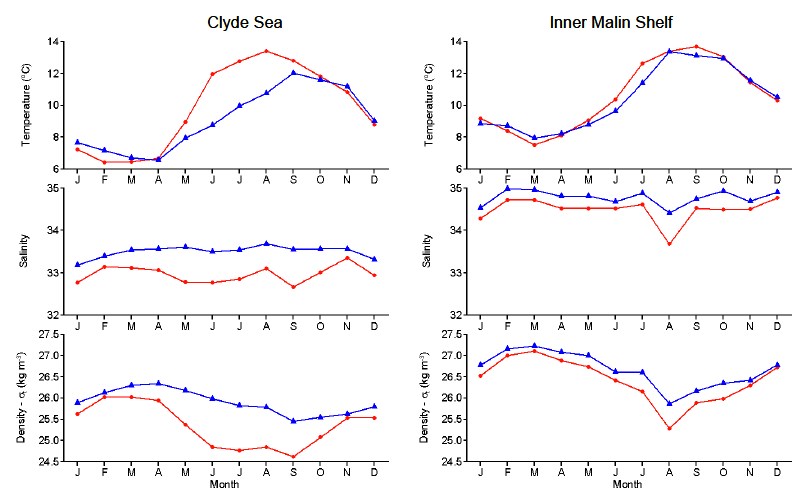
Figure 3.5b Average annual cycles in the Clyde Sea (left) and Inner Malin Shelf (right) of nitrate (μg-at/l), chlorophyll-a (μg/l) and oxygen (percent saturation) from Slesser and Turrell (2005). Data is presented for a surface layer (0-10m and 0-20m for Clyde and Inner Malin Shelf respectively - red symbols and lines) and for a bottom layer (40m to sea bed and 30m to sea bed for Clyde and Inner Malin Shelf respectively - blue symbols and lines). See Slesser and Turrell (2005) for a full description of the data and it's accuracy.
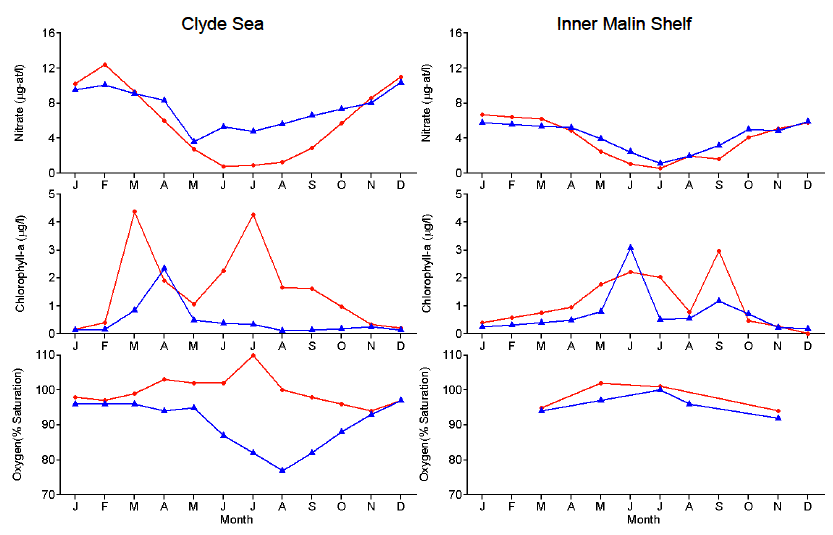
3.4.2 Warming Sea Temperatures
There is increasing evidence and agreement within the scientific community that the release of greenhouse gases into the atmosphere is the major cause of the observed average increase in global temperatures over the last century. Around the coast of Scotland an increase in sea temperatures has been observed which has the potential to alter the abundance and distribution of marine species. Marine Scotland currently maintains a network of coastal temperature monitoring stations around the coast of Scotland and at three of the sites (Millport, Fair Isle and Peterhead) data has been collected for more than 25 years. Recent analysis of temperature data from the sites currently monitored in the inshore areas show that the Clyde Sea may be warming faster than coastal waters within the North Sea ( Figure 3.4). The warming rate at Tiree is similar to that of the Clyde.
Figure 3.4 Long-term temperature anomalies plotted against year over common time period (1982-2008). Warming rates (ºC decade -1) from the linear fit to the data, Red, Millport, Green, Fair Isle, Blue, Peterhead, Black, Tiree.
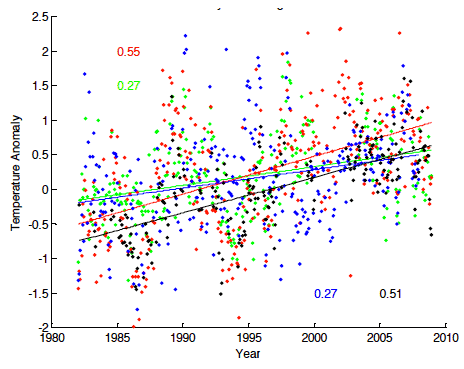
Plankton are at the base of the marine food web providing food for many species of fish and shellfish, and hence for the fish, birds and marine mammals which feed on them. They include bacteria, plants (phytoplankton) and animals (zooplankton). They play a fundamental role in the functioning of marine ecosystems by providing half of the global primary production (Waniek and Holliday, 2006). For an ecosystem, the availability of nutrients, larval survival, maintaining populations and the timing of egg production are highly dependent on the amount of plankton available (Barne et al., 1997).
The abundance of plankton is strongly influenced by factors such as light and nutrient availability, water temperature, depth within the water column, tidal mixing and the vertical stability of the water column. Plankton communities are surprisingly diverse and seasonal successions of communities are usually observed due to environmental conditions and the different adaptive strategies of plankton populations (Reynolds et al., 2001). The Firth of Clyde supports a rich flora and fauna (Haig, 1986) and early studies from the area showed that the main food pathway in this region was diatoms (one of the most common types of phytoplankton) to copepod to herring (Marshall, 1924; Marshall, 1973).
The spring increase in phytoplankton begins in March, with diatoms reaching a peak in May, dinoflagellates show a steady increase through the summer until September when abundance declines to winter levels. Dinoflagellates are of particular importance around Scotland because of the number of harmful genera that are routinely observed. Fish farms in the Firth of Clyde, particularly in Lochs Fyne and Striven, have lost stock due to such harmful phytoplankton blooms (Tett et al., 1986) and algal toxins have been recorded in shellfish from the region (Stobo et al. 2008). Not all harmful species seen in Scotland pose a severe problem. At the Millport monitoring site, Alexandrium spp. is observed infrequently and Pseudo-nitzschia spp. cell densities are low compared with other Scottish sites. Lipophilic shellfish toxins associated with Dinophysis are recorded in this region (Stobo et al. 2008) High cell densities of Karenia mikimotoi have been observed during the last two years at the Millport monitoring site ( Figure 3.6). Karenia blooms along the west coast of Scotland are sporadic in occurrence and there is some suggestion that they may have an offshore influence (Davidson et al., 2009). The 2006 bloom which had devastating impacts along the West Coast did not impact the Clyde. Although the cell densities at Millport were not associated with catastrophic mortalities of the benthos or wild or farmed fish, the impact on the biota of exposure to sub-lethal densities is relatively unknown. Figure 3.6 shows the diatom and dinoflagellates cell counts at Millport since 2005 which indicates a large amount of phytoplankton and thus high productivity during the phytoplankton blooms. Comparison with two other sites (Loch Ewe, Wester Ross and Scapa Bay, Orkney) from the MSS monitoring programme show a greater abundance of diatoms and dinoflagellates recorded at the Millport site (Figures 3.7 and 3.8).
Figure 3.6 Monthly averaged cell densities from 2005-2010 at Millport of a) diatoms; b) dinoflagellates and c) Karenia mikimotoi. Note data has been root-square transformed.
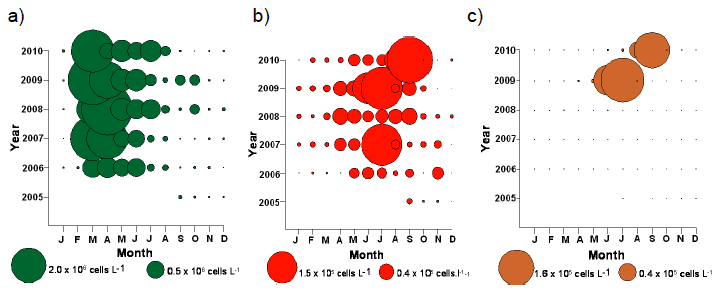
Figure 3.7 Monthly averaged cell densities from 2005-2010 at Loch Ewe of a) diatoms; b) dinoflagellates and c) Karenia mikimotoi. Note data has been root-square transformed.
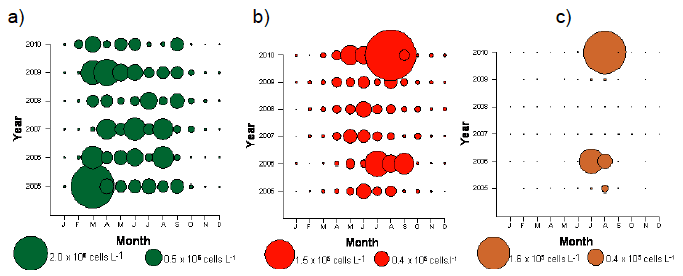
Figure 3.8 Monthly averaged cell densities from 2005-2010 at Scapa Flow of a) diatoms; b) dinoflagellates and c) Karenia mikimotoi. Note data has been root-square transformed.
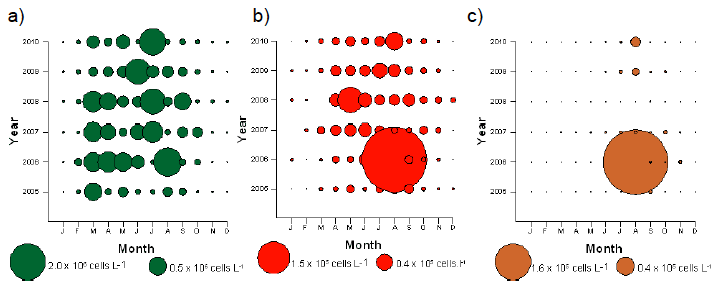
The zooplankton of the Firth of Clyde has been particularly well documented (Adams, 1986); it is dominated by copepods, euphausiids, arrow worms and jellyfish (Tett, 1992). Although the euphausiids species Meganyctiphanes norvegica and Thysanoessa raschii are important in the deep water around Arran and Loch Fyne, in general, the copepod Calanus sp are the most important pelagic crustaceans (Adams, 1986). The abundance of copepods in this region is quite high compared with other sites around Scotland's coast and the duration of seasonal abundance is quite prolonged compared with the northern North Sea (Barne et al., 1997). Calanus occurs in enormous numbers in surface waters throughout May and June after which this species is found mainly in deeper waters such as those of Loch Fyne (Tett, 1992).,
The Clyde Sea presents the overall characteristics of a semi-enclosed fjordic basin, receiving freshwater inputs from the land and having partial exchange with the waters on the adjacent coastal shelf at its mouth.
The sea bed physical habitats in the Clyde are dominated by the local depth, the local sediment type and the local tidal currents and wave action. The predominant shape and bathymetry of the Clyde basin, and the distribution of the principal sea bed types, including the gravels, sands and muds, have been little changed since the end of the last glacial period (ice age).
The basis of the marine food web in the Clyde, i.e. the annual cycle of plant (phytoplankton) growth, fed by water-borne nutrients, and the subsequent feeding and growth of microscopic animals (zooplankton), appears healthy and productive in the Clyde.
From large scale observations, there are no obvious signs of negative effects on the food web of pollution, nutrient enrichment or any other man-made source of contamination. This does not preclude the possibility of small-scale local effects.
Although the waters of the Clyde Sea are warming, this is in line with other coastal areas west of Scotland. There is no evidence that the warming in itself has reduced the potential productivity of the Clyde.
3.7 Suggestions for Further Work
The physical environment of the Clyde is determined by water movements driven by tide, wind and density-related forces arising from the input of freshwater within the Clyde. Additional water movement is driven by the effect of surface waves. Numerous hydrodynamic models of the Clyde have been constructed. However, as the physical environment is critical in determining the location and possible health of key sea bed habitats such as maerl beds, there is a need now for a state-of-the-art fine resolution ( e.g. 100m) three-dimensional hydrodynamic model using modern modelling technology such as the F- VCOM approach.
The picture presented here of a productive base of the food web in the Clyde is qualitative only. Although there have been numerous individual studies of aspects of the food web in the Clyde, no one quantitative overall assessment of the post-industrial (particularly after the cessation of the use of the Clyde for sewage disposal and the inclusion of the current effects of climate change) ecosystem productivity is available.
The best way to integrate the physics, chemistry and biology driving the Clyde marine ecosystem in a quantifiable way is by establishing an ecosystem model of the Clyde. Some already exist, although existing models each have particular limitations and focussed uses. When assembling such a model, critical parameters will be unavailable for the Clyde and this will direct observations and experiments.
An overall ecosystem model of the Clyde Sea is needed, whether spatially-resolved or simply a sub-basin scale box-type model ( e.g. based on an ecopath-type approach), through which scientific consensus can be achieved concerning the health and productivity of the Clyde marine ecosystem.
Contact
There is a problem
Thanks for your feedback